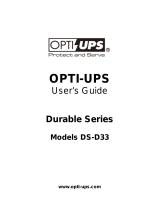Table of Contents
1. Safety ............................................................................................................................... 1
1.1 Important Safety Instructions ..................................................................................... 1
1.2 EMC .......................................................................................................................... 1
1.3 Installation information .............................................................................................. 1
1.4 Maintenance ............................................................................................................. 2
1.5 Recycling the used battery ......................................................................................... 2
2. Installation ........................................................................................................................ 3
2.1 Initial Inspection ....................................................................................................... 3
2.2 Installation Environment ............................................................................................ 3
2.3 Unpacking ................................................................................................................. 4
2.4 Moving the Cabinet .................................................................................................... 6
2.5 Types of UPS Cabinet ................................................................................................. 7
2.6 Exterior ..................................................................................................................... 8
2.7 Internal Mechanisms ................................................................................................ 11
2.8 Control Panel........................................................................................................... 16
2.9 Introduction of Modules ........................................................................................... 18
2.10 Power Cable .......................................................................................................... 24
2.11 Wiring ................................................................................................................... 25
2.12 Power Module Installation ...................................................................................... 28
2.13 Battery Module Installation ..................................................................................... 30
3. Operation Mode and UPS Operation .................................................................................. 31
3.1 Block diagram of UPS .............................................................................................. 31
3.2 Operation Mode ....................................................................................................... 32
3.3 UPS Operation ......................................................................................................... 40
4. Control Panel and Display Description ................................................................................ 51
4.1 Introduction ............................................................................................................ 51
4.2 Screen Description ................................................................................................... 52
4.3 Alarm List ............................................................................................................... 76
4.4 History Record ......................................................................................................... 78
5. Interface and Communication ........................................................................................... 80
5.1 Dry Contact Port ...................................................................................................... 80
5.2 Extra Comm. Slot .................................................................................................... 82
5.3 Local Communication Ports – RS232 & USB ............................................................... 82
5.4 SNMP Slot ............................................................................................................... 82
6. Troubleshooting ............................................................................................................... 83
7. Service ............................................................................................................................ 86
7.1
Replacement Procedures Of Power Module ................................................................ 86
7.2 Replacement Procedures Of STS Module ................................................................... 86
7.3 Replacement Procedures Of Battery Module .............................................................. 86
7.4 Replacement Procedures Of Air Filter ........................................................................ 87
8. Specifications .................................................................................................................. 88
8.1 Conformity And Standards ........................................................................................ 88
8.2 Environmental Characteristics ................................................................................... 88
8.3 Mechanical Characteristics ........................................................................................ 88
8.4 Electrical Characteristics (Input Rectifier) .................................................................. 89
8.5 Electrical Characteristics (Intermediate DC Circuit) ..................................................... 89
8.6 Electrical Characteristics (Inverter Output) ................................................................. 90





















